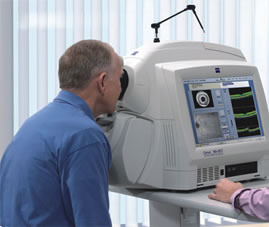
Glaucoma, a complex eye disease affecting millions worldwide, poses a significant challenge due to its progressive nature and potential for irreversible vision loss. While managing advanced stages of glaucoma can be daunting, recent innovations in both diagnosis and treatment offer renewed hope and possibilities for enhancing quality of life and preserving vision.

Optical Coherence Tomography (OCT) has revolutionized glaucoma management by providing detailed, cross-sectional images of the retina and optic nerve. Innovations in OCT technology, such as enhanced depth imaging and swept-source OCT, enable clinicians to detect subtle structural changes earlier. This precision allows for timely intervention to slow disease progression and preserve remaining vision.

AI-driven algorithms have transformed glaucoma diagnostics by analyzing complex OCT data with unmatched accuracy. These algorithms detect subtle optic nerve and retinal changes indicative of glaucoma, facilitating earlier diagnosis and personalized treatment strategies. By harnessing AI’s capabilities, clinicians can tailor interventions to individual patient needs, offering advanced care even in advanced stages of the disease.

Minimally Invasive Glaucoma Surgery (MIGS) represents a significant advancement in surgical options for glaucoma patients, particularly those with advanced disease. These microsurgical procedures, such as micro stent implantation and trabecular bypass devices, aim to improve aqueous humour outflow while minimizing trauma to the eye. MIGS offers potential benefits such as reduced dependence on medications and quicker recovery times compared to traditional surgeries.
MIGS procedures are associated with fewer complications and quicker recovery times, making them suitable options for patients, including those with advanced glaucoma who may be at higher risk for surgery-related complications.
Research into neuroprotective agents and regenerative treatments aims to preserve optic nerve function and potentially reverse damage in advanced glaucoma. Neurotrophic factors, antioxidants, and gene therapies show promise in protecting retinal ganglion cells (RGCs) and promoting nerve regeneration. These therapies not only aim to halt disease progression but also strive to restore visual function and improve quality of life for patients facing advanced stages of glaucoma.
Neuroprotective agents like brimonidine and memantine have demonstrated potential in reducing oxidative stress and inflammation within the retina, thereby preserving RGC function. These agents complement existing treatments by addressing the underlying mechanisms of neurodegeneration in glaucoma.
Regenerative therapies, including stem cell therapy and gene therapy, hold promise for repairing and replacing damaged retinal cells. These approaches aim to restore visual function by promoting cell survival and regeneration in the optic nerve, offering new hope for patients with advanced glaucoma.
The future of glaucoma care lies in personalized treatment strategies that consider individual patient characteristics, including genetic predispositions and disease progression patterns. By integrating genetic testing and biomarker analysis, clinicians can predict treatment responses more accurately and customize therapies to optimize outcomes while minimizing side effects.
Advancements in telemedicine and remote monitoring technologies facilitate ongoing care and real-time disease management for glaucoma patients. Virtual consultations, remote IOP monitoring, and mobile health applications enable patients to participate actively in their eye health management from anywhere, ensuring timely adjustments to treatment plans and enhancing overall treatment adherence.
As we navigate the evolving landscape of glaucoma treatment, these innovations offer tangible hope and possibilities for patients with advanced disease. From advanced diagnostics and minimally invasive surgeries to cutting-edge neuroprotection and regenerative therapies, the field of glaucoma care continues to advance, promising improved outcomes and preserved vision. By staying informed and engaged with their eye care providers, patients can embrace these advancements with confidence, knowing that the future holds promising solutions for managing and potentially reversing the impact of glaucoma.
Together, let’s continue to advocate for comprehensive glaucoma care that enhances quality of life and preserves vision for all patients, offering hope and progress in the journey against this challenging disease.

WhatsApp us